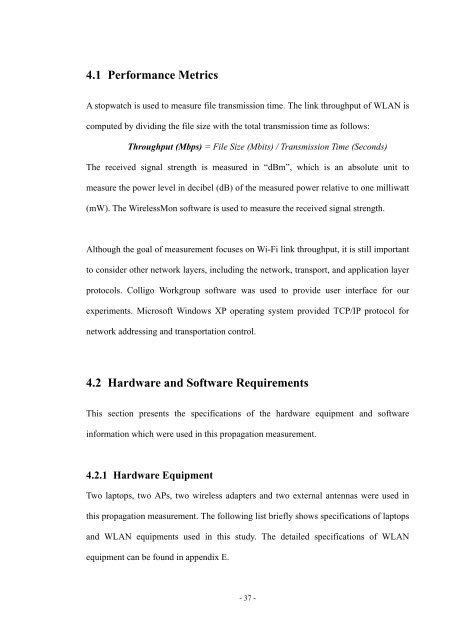An Investigation of the Impact of Signal Strength on Wi-Fi Link ...
An Investigation of the Impact of Signal Strength on Wi-Fi Link ...
An Investigation of the Impact of Signal Strength on Wi-Fi Link ...
You also want an ePaper? Increase the reach of your titles
YUMPU automatically turns print PDFs into web optimized ePapers that Google loves.
4.1 Performance Metrics<br />
A stopwatch is used to measure file transmissi<strong>on</strong> time. The link throughput <str<strong>on</strong>g>of</str<strong>on</strong>g> WLAN is<br />
computed by dividing <str<strong>on</strong>g>the</str<strong>on</strong>g> file size with <str<strong>on</strong>g>the</str<strong>on</strong>g> total transmissi<strong>on</strong> time as follows:<br />
Throughput (Mbps) = <strong>Fi</strong>le Size (Mbits) / Transmissi<strong>on</strong> Time (Sec<strong>on</strong>ds)<br />
The received signal strength is measured in “dBm”, which is an absolute unit to<br />
measure <str<strong>on</strong>g>the</str<strong>on</strong>g> power level in decibel (dB) <str<strong>on</strong>g>of</str<strong>on</strong>g> <str<strong>on</strong>g>the</str<strong>on</strong>g> measured power relative to <strong>on</strong>e milliwatt<br />
(mW). The <strong>Wi</strong>relessM<strong>on</strong> s<str<strong>on</strong>g>of</str<strong>on</strong>g>tware is used to measure <str<strong>on</strong>g>the</str<strong>on</strong>g> received signal strength.<br />
Although <str<strong>on</strong>g>the</str<strong>on</strong>g> goal <str<strong>on</strong>g>of</str<strong>on</strong>g> measurement focuses <strong>on</strong> <strong>Wi</strong>-<strong>Fi</strong> link throughput, it is still important<br />
to c<strong>on</strong>sider o<str<strong>on</strong>g>the</str<strong>on</strong>g>r network layers, including <str<strong>on</strong>g>the</str<strong>on</strong>g> network, transport, and applicati<strong>on</strong> layer<br />
protocols. Colligo Workgroup s<str<strong>on</strong>g>of</str<strong>on</strong>g>tware was used to provide user interface for our<br />
experiments. Micros<str<strong>on</strong>g>of</str<strong>on</strong>g>t <strong>Wi</strong>ndows XP operating system provided TCP/IP protocol for<br />
network addressing and transportati<strong>on</strong> c<strong>on</strong>trol.<br />
4.2 Hardware and S<str<strong>on</strong>g>of</str<strong>on</strong>g>tware Requirements<br />
This secti<strong>on</strong> presents <str<strong>on</strong>g>the</str<strong>on</strong>g> specificati<strong>on</strong>s <str<strong>on</strong>g>of</str<strong>on</strong>g> <str<strong>on</strong>g>the</str<strong>on</strong>g> hardware equipment and s<str<strong>on</strong>g>of</str<strong>on</strong>g>tware<br />
informati<strong>on</strong> which were used in this propagati<strong>on</strong> measurement.<br />
4.2.1 Hardware Equipment<br />
Two laptops, two APs, two wireless adapters and two external antennas were used in<br />
this propagati<strong>on</strong> measurement. The following list briefly shows specificati<strong>on</strong>s <str<strong>on</strong>g>of</str<strong>on</strong>g> laptops<br />
and WLAN equipments used in this study. The detailed specificati<strong>on</strong>s <str<strong>on</strong>g>of</str<strong>on</strong>g> WLAN<br />
equipment can be found in appendix E.<br />
- 37 -
















